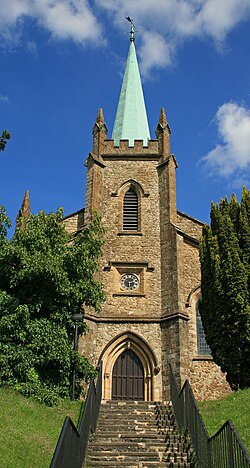Riverhead, Kent
| Riverhead | |
| Kent | |
|---|---|
 Church of St Mary, Riverhead | |
| Location | |
| Grid reference: | TQ514275 |
| Location: | 51°17’5"N, -0°10’12"E |
| Data | |
| Population: | 1,821 (2011) |
| Post town: | Sevenoaks |
| Postcode: | TN13 |
| Dialling code: | 01732 |
| Local Government | |
| Council: | Sevenoaks |
| Parliamentary constituency: |
Sevenoaks |
Riverhead is a northern village part of the urban area of Sevenoaks in Kent. The parish had a population of 2,634 at the 2011 Census.
The parish stretches from Chipstead Lake and the River Darent in the north through the hamlet of Dibden and the A21 to Mill Bank Wood in the south.
Parish church
The parish church, St Mary The Virgin, was built in 1831 to the design of Decimus Burton. It is in the late Georgian lancet style, executed in characteristic local materials. An extension was added in 1882 by Arthur William Blomfield, which shows how Victorian church design developed. The east window was installed in 1905 by Charles Eamer Kempe.[1]
History
The origin of the name of the village may lie in the Saxon word 'rither' meaning hill, or deriving from the word Hreðer meaning 'cattle'. It is part of the Codsheath Hundred. The settlement grew in size during Saxon times as traffic on the pilgrim routes between Canterbury and Winchester increased.
The prosperity of the village during Georgian times is indicated by the high proportion of households that had to pay Hearth Tax on their properties, and although the village was of modest size, it was surrounded by several major country estates such as Chipstead Place, Bradbourne and Montreal.
Riverhead had a variety of country industries typical of the area, including a tannery, a timber yard, smithies and the posting house. The economy was based mainly on agriculture, along with some gravel and sand quarrying to the north-east of the village that created the lakes around Bradbourne which are now a wildfowl reserve.
The village has a central conservation area that covers some 24.7 acres (10.0 ha) and contains about 30 listed buildings. The listed properties in the Conservation Area date from the 17th and 18th Century and the older unlisted properties date mainly from the 19th Century.
Society and events
Every year there is the Village Fete and Carnival on the little common, surrounded by residential roads in the west of the village, held by the 3rd Sevenoaks scout group.
There is one pub in Riverhead, The Bullfinch.[2]).
The village has a small clutch of local shops including a butchers on The Square, a couple of boutiques, a small art gallery, restaurants, a dry cleaners, barber, and hairdresser.
Sport and leisure
- Cricket: Holmesdale Cricket Club, who play at the top of Worship's Hill[3]
Behind the church is an area known as the sand pits which is popular amongst the young people in Riverhead. The area adjoins a steep sandstone cliff.
The Riverhead parkland is part of the former Montreal Park (the remaining part is an estate of houses), which offers walks and children's recreation areas traversing the Wealden Greensand vale of the Darent Valley between Riverhead Infants School and Brittains Lane, Sevenoaks.
Outside links
| ("Wikimedia Commons" has material about Riverhead, Kent) |
References
- ↑ National Heritage List 1272880: Church of St Mary (Grade II listing)
- ↑ "Bullfinch, Riverhead - McMullen". https://www.mcmullens.co.uk/bullfinch.
- ↑ Holmesdale Cricket Club
